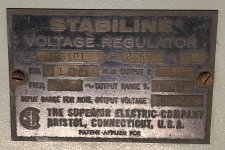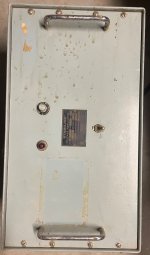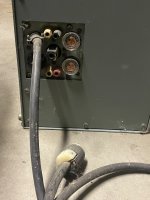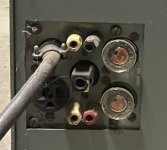I picked this up years ago. Employer wanted to toss it but asked to keep it. It is beast and very heavy > 50lbs. I believe it was used to regulate voltage to scientific instruments. I’m guessing it was from the 50-60s.
Others have told me to scrap it and some have said it could be used to regulate power to a tube amp. Looking for any additional thoughts. Moreover, I can no longer keep it and would like to get it to a new home where it can be appreciated.
See pics for details.
Thanks!
Others have told me to scrap it and some have said it could be used to regulate power to a tube amp. Looking for any additional thoughts. Moreover, I can no longer keep it and would like to get it to a new home where it can be appreciated.
See pics for details.
Thanks!
Attachments
These things can be useful in the lab.
They stabilize the mains voltage against variations of it, so would be useful to power test equipment for best performance.
Jan
They stabilize the mains voltage against variations of it, so would be useful to power test equipment for best performance.
Jan
Heck, that would be useful in my living room! During the summer my line voltage sometimes drops lower than 114VAC. It's quite hard on my tube amps. I bought a Furman regulator and it's pretty good but it still allows for certain variances. I'll bet the Stabiline does a better job.
Almost certainly a ferroresonant transformer. https://www.sunpower-uk.com/glossary/what-is-a-ferroresonant-power-supply/
Tube amps don't really need any regulation and those transformers can hum audibly loud.
Tube amps don't really need any regulation and those transformers can hum audibly loud.
Superior electric was a manufacturer of variacs. I recall these from years back; they are almost certainly motorized variacs. A simple voltage regulator with a few transistors acts to increase or decrease the motor position, which bucks or boosts the output voltage. They are somewhat slow responding, many cycles, but if you want zero SCR switching artifacts, they are a good solution. They are also quiet in comparison to ferroresonant transformers, as they do not run the cores in saturation.
Yers, if you google Stabiline you'll see that they are motor-driven variacs.
Almost certainly a ferroresonant transformer. https://www.sunpower-uk.com/glossary/what-is-a-ferroresonant-power-supply/
Tube amps don't really need any regulation and those transformers can hum audibly loud.
You could be right about the transformer noise. As for tube amps not needing regulation, well yes, they have wide tolerances but when the 5V rectifier is running at 4V and your B+ drops 20VDC or more, it's not ideal. Especially if, like my amps, they are limited to 20 wpc. Dropping a few watts per channel can make a difference. ;-)
I think the term "gross distortion" should be qualified. Ferroresonant transformers do have some distortion, and there are various types that attempt to clean up the wave differently. Some specifically are nameplated for harmonic performance.
Expecting something around 5% THD is not unreasonable, but expecting 0.1% distortion is not in the wheelhouse of what these are designed to do, nor would it be needed in most applications. If you have a device that needs this low level of distortion to run optimally, I would argue you have a poorly designed device, and yes that includes AC heated tube amps.
The claim to fame of FR transformers is a combination of fast regulation (2%), sinewave output (<5%), superior CMRR, and DM transient suppression. And this they do very well.
Feed them a square wave, they give you a decent regulated sine wave.
Feed them a triangle wave, they give you a decent regulated sine wave.
Feed them a stepped inverter, they give you a decent regulated sine wave.
Noisy input voltage with PWM and switching artifacts? No problem, they give you a decent regulated sine wave.
And just as important, their harmonic spectrum is friendly, with generally lower order harmonics and excellent rejection of higher order.
These stabiline power supplies, in comparison, simply pass-through the input sine wave and only function to correct the AC magnitude.
Expecting something around 5% THD is not unreasonable, but expecting 0.1% distortion is not in the wheelhouse of what these are designed to do, nor would it be needed in most applications. If you have a device that needs this low level of distortion to run optimally, I would argue you have a poorly designed device, and yes that includes AC heated tube amps.
The claim to fame of FR transformers is a combination of fast regulation (2%), sinewave output (<5%), superior CMRR, and DM transient suppression. And this they do very well.
Feed them a square wave, they give you a decent regulated sine wave.
Feed them a triangle wave, they give you a decent regulated sine wave.
Feed them a stepped inverter, they give you a decent regulated sine wave.
Noisy input voltage with PWM and switching artifacts? No problem, they give you a decent regulated sine wave.
And just as important, their harmonic spectrum is friendly, with generally lower order harmonics and excellent rejection of higher order.
These stabiline power supplies, in comparison, simply pass-through the input sine wave and only function to correct the AC magnitude.
I have a Claude Lions mains voltage stabilizer to power my bench; a 10A buck/boost transformer is fed by a motorised Variac driven by a (germanium!) servo. It's essential on the occasions when I plot a set of valve curves on the AVO VCM163. But beware that they sit there doing nothing, then suddenly move, so gentle drifts in mains voltage are replaced with smaller but sharp steps. It jumped out of a skip outside BBC Television Centre in 1985 and before that probably powered picture monitor racks before colour monitors had stabilized heater supplies. Yours sounds very similar.
- Home
- Amplifiers
- Tubes / Valves
- Stabiline Voltage Regulator Vintage Tube



